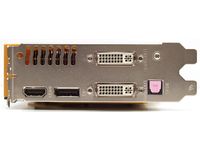Four GeForce 9600 GT Cards Compared
Palit GeForce 9600 GT Sonic (9600GT Sonic)
The 9600 cooler from Palit reminds us of MSI’s model. Its 70 mm fan sits in the middle of the cooler and an orange plastic housing protects the components. However, there is only a small opening in the slot cover for warm air. Remaining space is blocked by the additional monitor connectors. Ideally, a quarter of the GPU heat is blown out of the housing, whereas the rest bounces around within the case.
Only two heat pipes are used to distribute the heat of the graphics processor to the cooler; MSI uses four. Instead, Palit thought about cooling the memory chips, the heat of which is distributed on the cover plates.
The additional cooling encouraged Palit to increase the memory speed from the 900 MHz standard to 1,000 MHz. The GPU runs at 700 MHz, whereas the reference clock is 650 MHz. In comparison to the MSI card, Palit’s shader speed is increased even higher to 1,750 MHz. The clock speeds are anchored in the BIOS of the card, and can be used with any graphics driver version.
In our test, overclocking leads to a 6% to 7% increase in overall performance compared to the reference design. If you are able to increase the shader clock rate even higher, you will gain another 2% with a 3 GHz CPU. Since the memory chips are cooled by the cover plates, you can courageously experiment with these, but don’t forget the conditions of the warranty.
The GeForce 9600 GT (G94) graphics chip supports Shader Model 4.0 and DirectX 10. Palit equips the Sonic version with 1 GB of DDR3 graphic memory, which hardly gives you any advantage when using resolutions of up to 1920x1200 pixels without anti-aliasing (AA). In Crysis with AA, the frame rate increases from 5 to 7.5 fps when the memory is doubled. In the overall results of our test suite, you can see an increase in performance of only 0.3% with the additional memory. If you want to run two GeForce 9600 GT cards in SLI mode, you should go with the 1 GB version because the larger memory has more of an effect on performance, due to the higher GPU power.
A special feature here is the large number of connectivity options. The HDMI port sits directly on the slot cover, so an adapter is not necessary. There is an internal audio connection via a SPDIF cable and Palit puts an optical audio port on the slot cover as well. You can plug your monitors into either the two DVI ports or to the new DisplayPort; there is no extra video connector for Component or S-video.
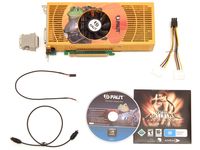
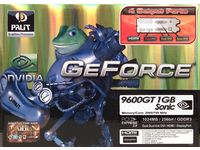
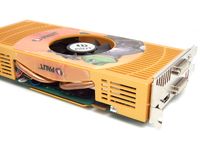
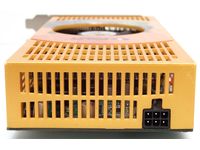
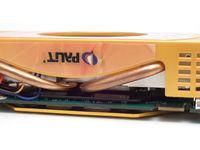
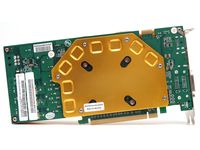

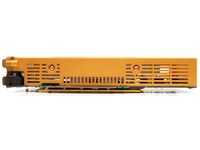
Get Tom's Hardware's best news and in-depth reviews, straight to your inbox.
Current page: Palit GeForce 9600 GT Sonic (9600GT Sonic)
Prev Page MSI Software Next Page Sparkle GeForce 9600 GT Calibre (Calibre P960 GBOX)-
JAYDEEJOHN So it beats the GTX eh? And you can find brand new nVidia drivers, but no ATI ones? And wheres the 4670? Got halfway thru, decided to skip the restReply -
jaragon13 What about the HD 4850? It costs less than the "last 8800 GTS 512's"Reply
Asus sells them for what? 170 dollars,free shipping on Newegg?
Maybe I even saw one @ 160... -
Sus-penders Why would anyone get an 8800GTS for $179 when you can buy a better performing HD 4850, for LESS money??? ATI still exists, you know...Reply -
Ryun No offense, as the article and tests run were good (I especially like the overall FPS charts), but this information would have been more pertinent, like, 6 months ago.Reply -
Niva Uh, I don't get what the people about are upset for. It's a good article, I enjoyed reading and seeing where these cards fit into the scheme of things. I know ATI has made a comeback with their recent cards but until their drivers are completely open and stable I'll stick with nVidia myself so I especially enjoyed this article. Thanks Toms!Reply -
L1qu1d Waste of 3 mins, it makes very little sense, the 9600 GTs in sli are around the 280 GTX in performance, yet it manages to get destroyed by the 4870.Reply
This article would've meant something around the time the cards came out...now I'd much rather like to see the 4850 cards compared or 260s or w.e else that is this gen. -
MooseMuffin NivaUh, I don't get what the people about are upset for. It's a good article, I enjoyed reading and seeing where these cards fit into the scheme of things. I know ATI has made a comeback with their recent cards but until their drivers are completely open and stable I'll stick with nVidia myself so I especially enjoyed this article. Thanks Toms!Reply
Exactly what is open about nvidia's drivers? -
warezme warms my heart to see the old 8800GTX included in this test list.Reply
It's amazing this ancient cards at default speed still sit in the middle of the pack and quickly rise to the top when you turn up AA and texture quality up, beating most every other card cept for 260GTX and SLI and CF rigs.
It also explains why a pair of old 8800GTX's in SLI OC'ed to at least Ultra speeds on a fast rig are still very hard to out perform by any single card (period) -
There is a reason to get the 9600GT over the 8800GT, power consumption. Look at the numbers, the 9600GT has 1/2 the number of shaders (hence a smaller die). I know the shader clock runs a little faster but a good quality stock PSU with 300W (real, like antec, corsair, etc) should be fine for running it.Reply

